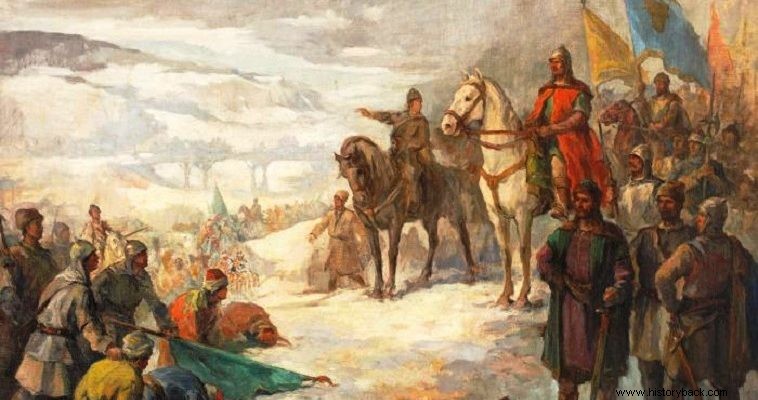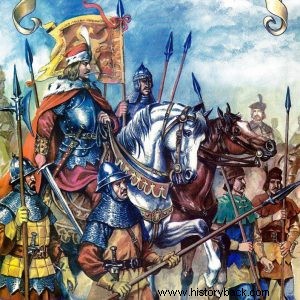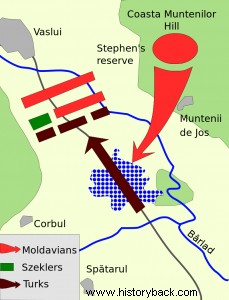
Stephen the Great of Moldavia, cousin of the famous Vlad Dracul, was one of the great personalities of the late Middle Ages and a fanatical opponent of the Turks. The area of Bessarabia was a point of friction between the Moldavian ruler and the Ottoman sultan Mohammed II. The Moldavian-Turkish conflict over Bessarabia began in 1420. After the Fall of the City in 1453, the Turks returned and made the then ruler of Moldavia subject to taxes.
In 1457 Stefanos became ruler with the help of his cousin. in 1465 Mohammed asked Stefanos to hand over the important port of Kelliia to him. Stephanos refused and after preparing he invaded Wallachia ruled by the vassal of the Turks Radu.
In 1473 Radu, reinforced with 12,000 Turks and 6,000 of his own soldiers, fought Stephen again but was defeated with the Moldavians occupying Bucharest. Soon, however, a new Turkish army forced Stephen to retreat to his country, while Muhammad again demanded the surrender of Cellia.
After the new refusal of Stephen, Mohammed ordered Suleiman Pasha to gather strong forces and attack with great forces against the Christian prince. Indeed Suleiman assembled a formidable army of 120,000 men joined by 17,000 Vlachs and 20,000 Bulgarian auxiliaries. The Turkish cavalry alone numbered 30,000 men.
Stefanos, of course, could not muster similar forces. He asked for help from the West but did not receive it. The Hungarians sent him 1,800 men and another 2,000 soldiers were sent by the Poles. He also recruited 5,000 hardened Transylvanians, many of whom were of German origin. Also 15,000 of his own soldiers while he recruited peasants and every man able to bear arms. In total his army numbered 49,000 men and 20 cannons.
Maneuvers
The Turkish army invaded Moldavia in December 1474. Stephanos followed the scorched earth tactic to wear down the enemy as much as possible. Light detachments of the army set up ambushes and exterminated any enemy who dared to cut off from the main body. The population with all the flocks moved north so that the Turks would be deprived of the necessities.
Suleiman was nevertheless marching towards Stephen's capital Suceava. Because of the winter and the shortages he was walking slowly. Stephanus was waiting for them at Vaslui in a strait protected by wooded hills on both sides while the river Barland flowed in front. It was January 10 of the Salvation year 1475.
There was only a wooden bridge across the river. Stephen ordered his forces into two lines of battle. In the first, on the right flank, were the Transylvanians and in the center and on the left were the regular troops of Stephen.
In the second line were the conscripted peasants. Stephanos, however, also sent part of his regular forces to his left flank, within the wooded hill of Costa Mundenilor. He placed himself at the head of the replacement force and waited for the Turks.
Stephanus implemented another strategy by sending the first line of his troops, together with trumpeters in the middle of the marshy valley of Podul Inalt, between his positions and the Turks. The sound of the trumpets made Suleiman believe that the Moldavians had grown up in the middle of the valley.
The Turkish army, divided into three divisions, moved against the first line of the Moldavians which, however, had orders not to engage but to retreat slowly towards the designated position , forward of the second line and towards the ambush.
Four-day massacre
Suleiman fell into the trap. He attacked the first enemy and seeing his men retreating followed them. Suddenly the Moldavian guns started firing. Moldavian archers and early rifle bearers followed. The Moldavians could not see him because of the fog. He was guided by the sound of the advancing Turks.
At the same time, Stephen's light cavalry began to attack the enemy and immediately disappeared in the fog. The Turks were fighting an "invisible" enemy with existing losses. Many Turks got stuck in the mud, others perished from the enemy missiles. With difficulty the Turks finally arrived before the main line of Moldavian resistance.
Suleiman launched 7,000 spachids against the Transylvanians but they repulsed them. But then, probably because of the fog, there was confusion and they fled. The Turks began to press the Moldavians, but then Stefanos rushed out with his reserve men.
With the trumpets sounding, Stephen and his men rushed to the side of the Turks, sweeping them away. Soon, in the fog, panic set in and Suleiman lost all control of his men. the Turks fled in disorder, pursued for the next three days by the Moldavian light cavalry and Stephen's Polish cavalry.
The Turkish army suffered untold destruction. Over 40,000 Turks were killed, but only 4,000 captured as the Moldavians were not feeling particularly philanthropic… and most of the enemy were beaten. However, the Vlachs did not participate in the battle. They were the first to run away.
After the battle and pursuit, Stephen sent four Turkish pasades and 36 banners to the Polish king Casimir as a gift for his assistance. He did the same with the pope and the Hungarian king Matthias Corvinus. Stefanos, it is worth noting, did not celebrate the victory. He fasted strictly for 40 days and dedicated his success to God.

Stefanos with his men.

